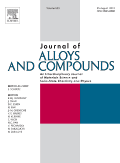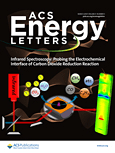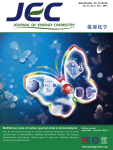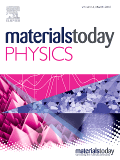
eScience
Scope & Guideline
Unlocking the Future of Materials and Renewable Energy
Introduction
Aims and Scopes
- Electrochemical Energy Storage:
Research on battery technologies, including lithium-ion, sodium-ion, and emerging battery systems, focusing on materials, interfaces, and performance enhancements. - Catalysis and Electrocatalysis:
Investigation of catalysts for energy conversion processes, including CO2 reduction, hydrogen evolution, and oxygen reduction reactions, with a focus on material design and mechanistic studies. - Materials Science and Engineering:
Development of novel materials for energy applications, including nanostructured electrodes, electrolytes, and composites, emphasizing their synthesis, characterization, and performance. - Sustainable Energy Solutions:
Exploration of sustainable approaches in energy materials and technologies, including recycling, self-healing materials, and environmentally friendly processes. - Optoelectronics and Photovoltaics:
Research on materials and devices for solar energy conversion, including organic photovoltaics, perovskite solar cells, and optoelectronic devices.
Trending and Emerging
- Next-Generation Battery Technologies:
Emerging themes in solid-state batteries, sodium-ion batteries, and lithium-sulfur batteries are gaining traction, highlighting the need for alternative energy storage solutions that offer improved safety, capacity, and sustainability. - Advanced Catalysts and Electrocatalysts:
There is a growing focus on the development of advanced catalysts, including single-atom catalysts and novel nanostructured materials, aimed at enhancing the efficiency of electrochemical reactions for energy conversion. - Integration of Machine Learning and AI:
The incorporation of machine learning and artificial intelligence in materials design and optimization is a rising trend, reflecting the industry's shift towards data-driven approaches for accelerating research and development. - Sustainable and Green Chemistry:
Research emphasizing sustainability, including biodegradable materials, recyclable components, and environmentally friendly processes, is becoming increasingly prominent as the field seeks to address global energy challenges. - Multi-Functional Materials and Devices:
There is a trend towards the development of multifunctional materials that serve multiple roles in energy systems, such as electrodes that also possess sensing capabilities, reflecting the interdisciplinary nature of current research.
Declining or Waning
- Traditional Lithium-Ion Technologies:
While lithium-ion batteries remain a key area, there is a noticeable decline in studies focusing solely on conventional lithium-ion technologies, as researchers increasingly explore alternative battery chemistries and architectures. - Low-Temperature Electrochemical Systems:
Research focused on low-temperature electrochemical processes has waned, possibly due to the growing interest in high-performance systems that can operate efficiently at elevated temperatures. - Basic Electrochemical Characterization Techniques:
There appears to be a decrease in publications centered on basic electrochemical characterization methods, as the field moves towards more advanced and integrated approaches that combine multiple characterization techniques.
Similar Journals

Journal of Alloys and Compounds
Exploring Breakthroughs in Metallurgy and Materials ScienceJournal of Alloys and Compounds, published by Elsevier Science SA, stands at the forefront of materials research, focusing on the properties, applications, and innovations within alloys and compounds. With an impressive impact factor and prestigious rankings placing it in the Q1 quartile across multiple related categories—including Materials Chemistry, Mechanical Engineering, and Mechanics of Materials—this journal is recognized for its significant contributions to the field. Researchers and professionals engaged in metallurgy, materials science, and engineering will find it a critical resource that encompasses groundbreaking studies, insightful reviews, and essential findings. The journal has a strong influence, as evidenced by its Scopus rankings—ranking 14th in Metals and Alloys and 28th in Mechanics of Materials, indicating a robust global impact. As it continues to publish cutting-edge research from 1991 to 2024, the Journal of Alloys and Compounds serves as a vital platform for the exchange of knowledge, thereby advancing our understanding of complex materials and fostering innovation in diverse applications.

Catalysts
Connecting Researchers through Open Access Catalysis InsightsCatalysts is a leading academic journal in the field of catalysis, published by MDPI since 2011 and well-regarded for its commitment to open access publishing. Based in Switzerland, this journal delivers innovative research and reviews that span various aspects of catalysis, from heterogeneous and homogeneous catalysis to the development of novel catalytic systems. With a commendable impact factor and a notable Q2 ranking in both Catalysis and Physical and Theoretical Chemistry categories, Catalysts plays a critical role in advancing the scientific discourse in these fields. The open-access model ensures that all research articles are readily accessible to researchers and professionals worldwide, fostering collaboration and accessibility to high-quality scientific literature. As the journal continues to publish cutting-edge studies up to its convergence in 2024, it remains an essential resource for anyone involved in catalysis research, from seasoned professionals to emerging scholars.

Electrochemical Energy Reviews
Transforming Energy Landscapes with Cutting-edge ResearchElectrochemical Energy Reviews, published by SpringerNature, serves as an essential platform for the dissemination of cutting-edge research in the fields of electrochemistry, material science, and energy engineering. With an impressive impact factor and ranked in the Q1 category across multiple disciplines including Chemical Engineering and Energy Technology, this journal highlights its commitment to advancing knowledge and innovation within the energy sector. Operating since 2018, the journal not only provides a valuable resource for researchers and professionals but also invites contributions from students and emerging scholars interested in the pivotal role of electrochemical processes in sustainable energy solutions. Published in Germany and widely accessible to the global research community, Electrochemical Energy Reviews is an indispensable reference for those keen on exploring the future of energy technologies.

Energy Materials
Empowering Energy Technologies Through Cutting-Edge Research.Energy Materials is a pioneering journal published by OAE PUBLISHING INC, dedicated to the dynamic field of energy materials science and engineering. With a focus on advancing knowledge related to materials used in various energy applications such as batteries, fuel cells, and solar cells, this open-access journal aims to disseminate cutting-edge research and innovative methodologies to a global audience. By offering a platform for original research, reviews, and case studies, Energy Materials plays a crucial role in bridging the gap between materials science and energy technology, facilitating the development of sustainable energy solutions. Researchers, professionals, and students alike will find invaluable insights in its pages, fostering advancements in this essential sector. To explore the latest developments in energy materials, visit Energy Materials at OAE PUBLISHING INC.

ACS Energy Letters
Unveiling Breakthroughs in Energy Science and TechnologyACS Energy Letters, published by the American Chemical Society, is a prestigious peer-reviewed journal designed to disseminate innovative and impactful research in the multifaceted field of energy science. Since its inception in 2016, the journal has quickly ascended to a remarkable status, achieving Q1 rankings in critical categories including Chemistry (miscellaneous), Energy Engineering and Power Technology, Fuel Technology, Materials Chemistry, and Renewable Energy, Sustainability and the Environment as of 2023. With an emphasis on rigorous research methodologies and interdisciplinary collaboration, ACS Energy Letters serves as a vital platform for scholars, professionals, and students to explore cutting-edge research that addresses contemporary energy challenges. While maintaining a commitment to advancing knowledge without open access, it offers profound insights into sustainable practices and innovative solutions that are crucial for the future of energy systems globally. The journal's esteemed standing in the chemical and energy sectors underscores its significance, making it an essential resource for anyone invested in the advancement of energy technologies and sustainable practices.

Carbon Energy
Advancing sustainable solutions for a greener tomorrow.Welcome to Carbon Energy, an esteemed open-access journal published by WILEY that focuses on cutting-edge research in the field of energy and materials science. Since its inception in 2019, this journal has quickly established itself as a leading platform for disseminating impactful findings and innovations related to carbon-based energy solutions, renewable resources, and sustainability practices. With its impressive Q1 rankings in multiple categories—including Energy (miscellaneous), Materials Chemistry, and Renewable Energy—Carbon Energy is recognized for delivering high-quality, peer-reviewed content that meets the rigorous standards of the academic community. Through its open-access model, the journal ensures wide accessibility of research findings, making it an invaluable resource for researchers, professionals, and students alike. As we look toward the future, Carbon Energy aims to further its mission of advancing sustainable energy technologies and promoting interdisciplinary collaboration in tackling global energy challenges.

Journal of Electrochemical Science and Technology
Catalyzing Innovation in Electrochemical TechnologiesJournal of Electrochemical Science and Technology, with the ISSN 2093-8551, is a distinguished publication in the field of electrochemistry, disseminated by the Korean Electrochemistry Society. Based in South Korea, the journal has made significant strides since its inception in 2014, showcasing groundbreaking research that spans various applications of electrochemical science. Currently ranked in the Q2 category for Electrochemistry, it occupies an emerging position within the academic community, evidenced by its Scopus rank of #25 out of 60 in the Electrochemistry domain, placing it in the 59th percentile. Although the journal follows a traditional access model, it remains committed to providing high-quality, peer-reviewed content that fuels innovation and scholarly dialogue. With objectives firmly rooted in advancing the understanding and application of electrochemical phenomena, this journal serves as a crucial resource for researchers, professionals, and students alike, striving to push the boundaries of the electrochemical sciences.

Journal of Energy Chemistry
Advancing the Future of Energy SolutionsThe Journal of Energy Chemistry, published by Elsevier, is a premier international journal that has established itself at the forefront of research in the fields of electrochemistry and energy technology. With an impressive impact factor, this journal is classified in the Q1 quartile across multiple categories including Energy Engineering and Power Technology, Fuel Technology, and Electrochemistry, underscoring its significant contribution to advancing knowledge and innovation in energy systems. Based in the Netherlands, the journal offers open access to its cutting-edge research, allowing for broad dissemination and engagement among researchers, professionals, and students alike. The scope of the journal spans crucial topics from chemical energy storage to sustainable energy solutions, making it an essential resource for those looking to understand and contribute to the evolving landscape of energy chemistry.

Materials Today Physics
Transforming Ideas into Sustainable Solutions through Materials ScienceMaterials Today Physics, published by Elsevier, is a prestigious journal that focuses on the interdisciplinary field of materials science, physics, and energy innovations. With an impressive impact factor and a Q1 ranking in three categories—Energy (miscellaneous), Materials Science (miscellaneous), and Physics and Astronomy (miscellaneous)—it stands out as a key platform for disseminating high-quality research. The journal, which has been in circulation since 2017, provides a vital resource for academics and industry professionals alike, facilitating the exchange of knowledge and driving advancements in materials research. Available in both traditional and open-access formats, Materials Today Physics aims to publish cutting-edge research articles that push the boundaries of material properties and their applications, thereby contributing to the development of sustainable technologies and energy solutions. With a commitment to excellence, this journal offers a robust avenue for researchers to share their findings with a global audience, making it an essential tool for those engaged in the rapidly evolving fields of physics and materials science.

Journal of Physics-Energy
Unlocking Innovations in Physics and EnergyJournal of Physics-Energy, published by IOP Publishing Ltd, is a leading Open Access journal that serves as a dynamic platform for the dissemination of high-quality research within the interdisciplinary realms of energy, materials science, and materials chemistry. Since its inception in 2019, the journal has gained remarkable recognition, achieving a prestigious Q1 ranking in multiple categories in 2023, highlighting its impact within these rapidly evolving fields. With its Scopus Ranks, placing it in the top 10% of journals for General Energy and within the top 20% for Materials Science disciplines, it reflects the commitment to excellence in research and innovation. Conveniently based in the United Kingdom, the journal is designed to facilitate collaboration and knowledge exchange among researchers, professionals, and students dedicated to advancing the understanding of energy technologies and materials science. The open access model ensures that cutting-edge research is freely available, promoting global accessibility and engagement with the latest scientific advancements.